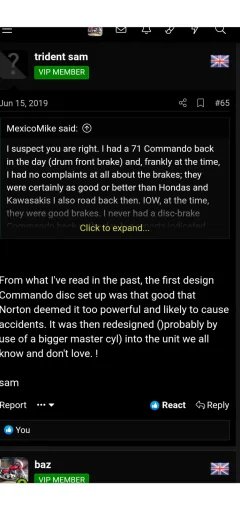SteveA
VIP MEMBER
- Joined
- Dec 20, 2011
- Messages
- 3,409
Hmm...tamed my arse!!Don't forget the front disc had to be tamed down with a larger master cylinder for the American market
And the ISOs and swinging arm pivot pin must be in fine fettle to handle really well
I've never ridden a p11 so I can't compare but a commando will sit at 90+ mph for mile after mile dead smooth
That's one of the attractions for me
The effortless miles they can eat up
AP Lockheed were frankly stupid when it came to master cylinder bore, christ knows why Norton went with their ideas!
AP did not supply a cylinder suitable for a single disc, and really they don't now in their classic replica range. AP really only made a master suitable for twin discs (5/8" or 15.8mm bore).
It wasn't just the Norton set up that suffered. I bought a Rickman chassis new in late '75, it had AP Lockheed brakes front and rear as of course Rickman pioneered these brakes in 1966.
The force needed to stop the thing was huge, the feel was like trying to squeeze hardwood. Yes, it stopped better than my Fastback Commando, but the bike did weigh a lot less and it did have race tyres.
Unfortunately, at the time I didn't know a smaller master would have changed things completely....I do now and with a 12.7mm (1/2") bore master the same brake design with modern SBS pads is really great., less force, more feel and better stopping overall.


